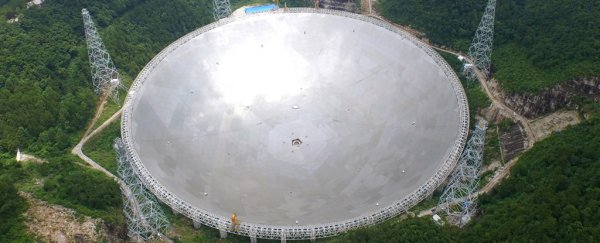A little over a year since its completion, China's 500-metre Aperture Spherical Telescope (FAST for short) has just made its first confirmed discovery.
Astronomers used the giant dish to spot a pair of pulsars thousands of light years away, heralding big things for what is now the world's largest single dish radio telescope.
The stars, called PSR J1859-01 and PSR J1931-01, were detected by the telescope back in August, but it took a few extra months until the Parkes telescope in Australia could confirm them as the real deal.
Both objects are dense, rapidly spinning stars surrounded by strong magnetic fields. These fields channel electromagnetic radiation into a beam that describes a circle with every rotation, much like a cosmic lighthouse.
Seen from Earth, the stars seem to pulse with every sweep, giving them their name pulsar. Their positions and timing make for useful landmarks in space, not to mention handy cosmic clocks for testing general relativity.
The pair discovered by FAST – also dubbed FP1 and FP2 – don't stand out in terms of size, speed, or distance.
"FP1 is a pulsar with a spin period of 1.83 second and an estimated distance of 16 thousand light-years, and FP2, is a pulsar with a spin period of 0.59 second and an estimated distance of 4,100 light years," says deputy chief engineer of FAST, Li Di.
For a comparison, the fastest pulsar turns on its axis an insane 642 times per second.
In February the European Space Agency found a pulsar that was a thousand times brighter than ever thought possible, 50 million light years away.
But give it a chance – FAST exceeds the 305 metre wide Arecibo Observatory in Puerto Rico as the largest dish of its kind, so far more impressive discoveries are surely yet to come.
"The two new discovered pulsars symbolise the dawn of a new era of systematic discoveries by Chinese radio telescopes," says Yan Jun, director of the National Astronomical Observatories of China.
The US$185 million facility was built to collect radio waves washing over the planet from the far reaches of deep space, allowing researchers to pick up faint traces of radiation from ancient clouds of hydrogen gas, distant black holes, pulsars, or … just maybe … alien wifi.
The dish sits inside a giant sinkhole in Guizhou Province, southwest China, where limestone has dissolved away to leave a massive depression.
The stats are impressive; 4,450 panels give the dish a collection area of 196,000 square metres (about 2,109,700 square feet), more than doubling Arecibo's coverage.
A bigger dish can collect more radio waves, which means detecting fainter signals; just the thing we need to see deeper into space, and therefore further back in time.
This hollow amid the surrounding hills provides a natural shelter from more Earthly radio waves, giving FAST a quiet spot to stare at the heavens.
Closer to home, the giant dish could also be used to track spacecraft travelling to Mars as part of China's burgeoning space program.
China has been making extraordinary leaps in space-based technology in recent years, such as facilitating the first quantum-encrypted satellite link-up just a few weeks ago.
Earlier this year the China Aerospace Science and Technology Corporation announced it would be conducting a record 30 launches into space this year, maintaining a trend in recent years that could see it meet its goal of landing technology on Mars by 2020.
FAST is just one more example of the nation's rapid progress in space technology. While it still has a few more tests to conduct to fine tune its processes, it won't be long before the facility is available to astronomers all over the globe.
We can't wait to see what else it discovers.
